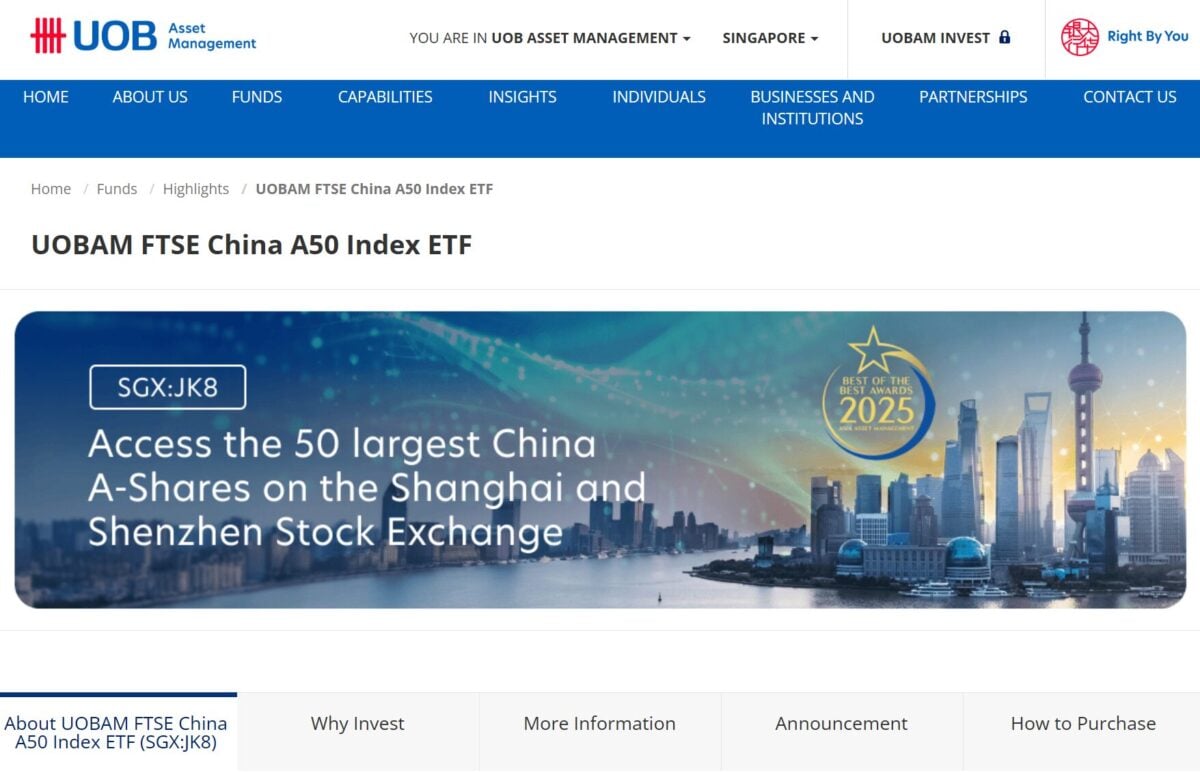
This article is written in collaboration with DBS. All views expressed in this article are the independent opinion of DollarsAndSense.sg based on our research, and is purely for informational purposes and should not be relied upon as financial advice. DollarsAndSense.sg is not liable for any financial losses that may arise from any transactions and readers are encouraged to do their own due diligence. You can view our full editorial policy.
Singapore investors are naturally drawn to the US stock market, home to the biggest and most exciting stocks in the world.
Just think to names like Amazon, Alphabet (formerly Google), Apple, Meta (formerly Facebook), Microsoft, Nvidia and Tesla – collectively named the Magnificent 7. Other famous industry-leading US companies include Visa, Mastercard, Walt Disney, Berkshire Hathaway, Coca Cola, Ford Motor, Pfizer and so many more.
Besides the growth opportunities, the US stock market is by far the biggest and most liquid, with a market capitalisation of close to US$60 trillion.
Read Also: Work & Invest: How Our Lifelong Learning Journey Is Similar To An Investment Journey
Building A Core-Satellite Portfolio With US Stocks
As individuals, we may have preferences in specific sectors and even stocks that we want to invest in. They could be companies that we believe have strong growth potential in the long-term or simply want to gain exposure to certain counters in the shorter-term.
Regardless of our convictions in such investments, though, we must first lay a strong foundation for our overall investment portfolio. This core portion of our portfolio should be broadly diversified to help us achieve stable market returns over the long-term.
One way to build this core portfolio is to simply gain exposure to the benchmark S&P 500 Index, comprising 500 leading companies in the US, which makes up nearly 80% of the US market capitalisation.
While we may be investing in US companies, we can also rest assured that our investment is broadly well-diversified. Highlighting this point, over 40% of the revenues generated by companies on the S&P 500 Index are derived outside of the US.

Source: FactSet
That’s why, the returns of the US market may be referred to as the market returns. Looking at the past 10 years, the S&P 500 index has delivered an annualised return of 13%. This is a healthy return that compounds our nest egg over the long run.
We can then complement such a core equity portfolio with more concentrated satellite investments. This typically means opportunistically investing in trending themes that we believe can outperform the average market return, especially in the shorter-term.
As satellite portfolios can be riskier and less diversified, they should be thought of as smaller supplementary parts of our portfolio. Ideally, we should limit our satellite portfolio to about 10% to 20% of our overall investment portfolio.
Such an allocation still gives us a potential upside with exposure to higher growth opportunities, while also limiting our downside.
Read Also: Why The Glidepath Is Vital For Managing Risk In Retirement Portfolios
Build More Balanced Satellite Positions With US Fractional Shares
If we want a satellite portfolio with exposure to the magnificent 7 companies, we may have to fork out US$2,226.65 buying one share in each of them.
| US Magnificent 7 Stocks | Price |
| Alphabet | US$194.41 |
| Amazon | US$220.66 |
| Apple | US$228.26 |
| Meta | US$611.30 |
| Microsoft | US$424.58 |
| NVIDIA | US$133.62 |
| Tesla | US$413.82 |
| Total | US$2,226.65 |
Source: Google Finance (as at 16 Jan 2025)
If we want to increase our exposure to the Magnificent 7 stocks, we will also have to invest a similar amount (depending on market movements). This may not be accessible for everyone, especially newer and younger investors.
At the same time, our investment of US$2,226.65 will be not evenly distributed across the Magnificent 7 stocks. Due to differences in their stock price, Meta will have the largest weightage at over 27% of our investment, while NVIDIA will have the smallest weightage at about 6%. In an ideal world, we may want about 14% allocation to each Magnificent 7 stock. Or we may prefer to divide our investment based on market capitalisation – which would mean Nvidia should have the largest weightage rather than smallest, while Tesla should have the smallest weightage instead of third largest based on price.
With US fractional shares investing that many brokerages offer today, we no longer have to buy one whole share, and can invest in a fraction of a share instead. For example, DBS Vickers allows us to invest in a fraction of a share from US$5 – making US stocks more accessible for all.
Now, we can invest in the biggest companies in the world from as little as US$5. Take the scenario that we want to invest US$1,000 a month into both our core and satellite portfolios, and may only want to allocate 20% to our satellite investments.
In the past, we may have had to wait close to a year before we can buy one share of each Magnificent 7 stock. With US fractional shares investing, we can now invest regularly, such as every month in our example, while choosing our preferred allocation to each share as well.
Making smaller and more regular investments also allows us to enjoy the benefits of dollar-cost averaging into the markets. This means we buy more of a counter when prices are lower and less when prices are higher – leading to an average overall price in the longer-term.
Read Also: How To Start Building Multiple Retirement Income Streams
Stress-Free Way To Build Your Core And Satellite Portfolios With US Fractional Investing
In the example above, we mentioned that we want to invest US$1,000 into both our core and satellite portfolios. With 80% allocation to our core portfolio, we will also not be able to invest US$800 evenly into a core portfolio.
Not to fret again. With US fractional shares investing, DBS Vickers allows us to invest in close to 100 ETFs and an extensive list of individual S&P 500 constituent stocks. This means we can buy fractional amounts of S&P 500 ETFs as well.
For example, if we invest in an S&P 500 ETF, such as the iShares Core S&P 500 ETF (trading at US$594.62) or the SPDR S&P 500 ETF (trading at US$591.64), we would only be able to buy one unit and always have leftover investment amounts. We then have to remember these amounts and buy two units after every five months or so when we’ve accumulated sufficient balances.
Cost is another main consideration when we aim to regularly build our investment portfolio each month. Brokerages understand this as well, and DBS Vickers sets a flat commission of US$0.96 (inclusive of GST) of US fractional trades when we buy or sell less than one share. Investors aged 18 to 25, holding a Young Investors Account, enjoy zero commission fee for US fractional buy and sell trades with less than one share.
Investing in fractional US stocks and ETFs also mean we have to pay in US Dollars. Naturally, we should be attentive to foreign exchange (FX) fees and charges, as well as the spread. Again, with DBS Vickers, we have less to worry about as payment will be made via our multicurrency account. This means there is full transparency in the exchange rates that we get, and no additional FX fees and charges when we invest. At the same time, when we sell our US fractional shares and ETFs or receive dividends, they will not be automatically converted into SGD. Instead, we will receive the funds in USD into our multicurrency account. Again, we don’t have to worry about any unknown exchange rates or FX fees and charges.
By choosing to build our investment portfolio via a bank, which offers comprehensive financial products, we can enjoy peripheral benefits too. For example, when we make US fractional shares trades via DBS Vickers, it is an eligible transaction that can potentially earn us higher bonus interest on our DBS Multiplier savings.
Similarly, we can also capture all our savings and investment information in one platform using DBS. Apart from savings accounts and equities trading, DBS also offers a comprehensive range of robo-advisory solutions via digiPortfolio, unit trust investments and fixed income products. We won’t have to go to multiple platforms for access or to get a bird’s eye view of our overall portfolio.
For those interested in US fractional shares investing, you can be eligible for free US$30 worth of Apple shares, if you open a new DBS Vickers account by 31 March 2025 and make one online US buy trade before 30 April 2025.
Read Also: DBS / POSB Multiplier Account: Earn Higher Interest As You Make Better Financial Decisions
Disclaimers and Important Notice
This article is for general information only and should not be relied upon as financial advice. All stocks mentioned are for illustration purposes only. Any views, opinions or recommendation expressed in this article does not take into account the specific investment objectives, financial situation or particular needs of any particular person. Before making any decision to buy, sell or hold any investment or insurance product, you should seek advice from a financial adviser regarding its suitability.
This advertisement has not been reviewed by the Monetary Authority of Singapore.
The information and opinions contained in this article has been obtained from sources believed to be reliable, but DBS makes no representation or warranty as to its adequacy, completeness, accuracy or timeliness for any particular purpose.
This article is not intended for distribution to, or use by, any person or entity in any jurisdiction or country where such distribution or use would be contrary to law or regulation.
It is provided in Singapore by DBS Bank Ltd (Company Registration. No.: 196800306E), an Exempt Financial Adviser as defined in the Financial Advisers Act and regulated by the Monetary Authority of Singapore.
All investments come with risks and you can lose money on your investment. Invest only if you understand and can monitor your investment. Diversify your investments and avoid investing a large portion of your money in a single product issuer.
The post How Investing In The US Stock Market With Fractional Shares Can Be Useful In Building A Core-Satellite Portfolio appeared first on DollarsAndSense.sg.











